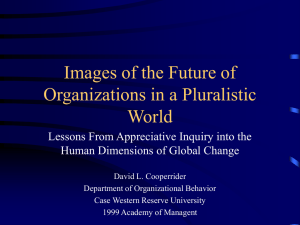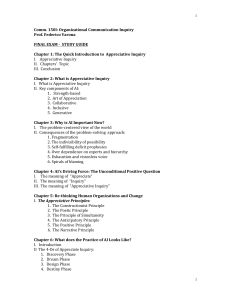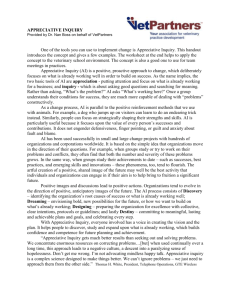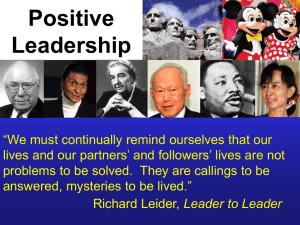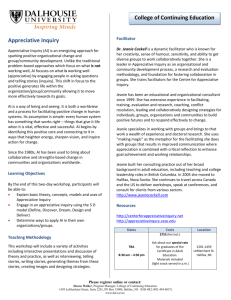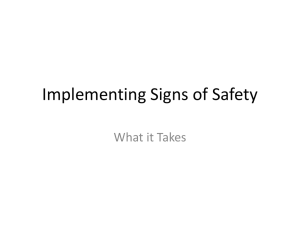(AI), Continued
advertisement
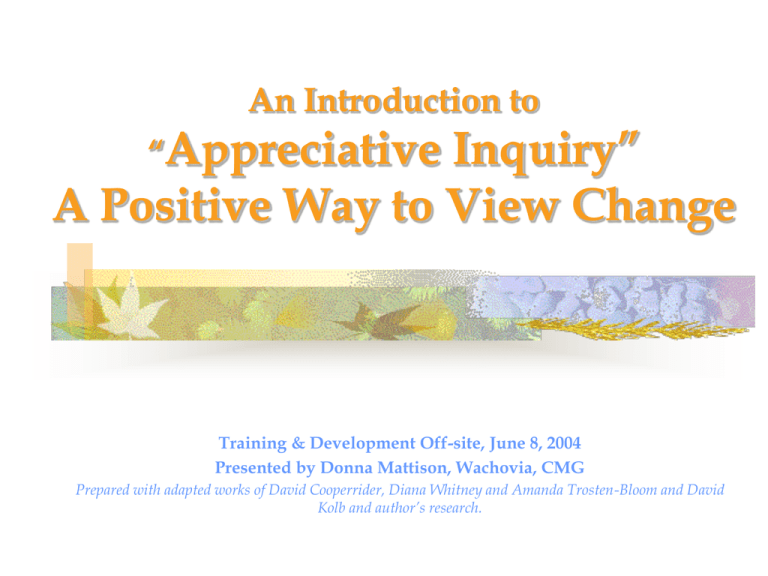
An Introduction to “Appreciative Inquiry” A Positive Way to View Change Training & Development Off-site, June 8, 2004 Presented by Donna Mattison, Wachovia, CMG Prepared with adapted works of David Cooperrider, Diana Whitney and Amanda Trosten-Bloom and David Kolb and author’s research. Table of Contents It's Time For A Change ……………………………………… Appreciative Inquiry (AI) Descriptions……………………… Problem Solving Approaches……………………………….. Appreciative Inquiry 4-D Cycle (Model)…………………….. Appreciative Inquiry 8 Principles……………………………. Potential Uses for Appreciative Inquiry…………………….. Applying AI in Business……………………………………… Appreciative Inquiry and Experiential Learning……………. Experiential Learning (EL) Explained………………………. EL Learning Cycle (David Kolb)…………………………….. AI & EL Merged………………………………………………. AI Exercise (first 2 phases)…………………………………. Explanation of How AI would fit in last two phases………… Summary………………………………………………………. Reference……………………………………………………… 3 4 6 7 11 13 14 15 16 17 19 21 27 28 28 29 29 30 2 It is a Time for Re-thinking Human Organization & Change… Globalization, workforce demographics and technology has created transformational shifts for organizations. With this comes increasing complexity with ambiguous, novel problems and continual challenges for change. We’re also experiencing trends toward creating value through people where the intangibles, such as leadership, culture and relationships make a difference to an organization’s bottom line and competitive advantage. During the next 15 years, we also face drops in workforce growth and the problem won’t just be a lack of bodies. Skills, knowledge, experience, and relationships are walking out the door. Therefore, collaboration and knowledge sharing are moving to the forefront of organizational strategies. 3 Appreciative Inquiry (AI) •Is the study and exploration of what gives life to human systems when they function at their best. •Is based on the assumption that questions and dialogue about strengths, successes, values, hopes and dreams are themselves transformational. • Suggests that human organizing and change, at its best, is a relational process of inquiry grounded in affirmation and appreciation. 4 Appreciative Inquiry (AI), Continued AI is a simple technique with a complex background. It has been used successfully all over the world to consult with people and learn from their experiences, to involve whole organizations in change and development and to build a vision for the future that everyone can share and help put into practice. Appreciative Inquiry is a technique that can easily be learned and adapted for a range of situations. It is an approach that involves and engages people. It encourages listening and communication skills and above all it empowers individuals and demonstrates respect for each other’s views. 5 2 Problem-Solving Approaches Deficit-Based • Have Pain Appreciative Inquiry Reflecting on what we do best • Identify the Problems Disseminate stories & best practices • Root Cause Analysis Narrative analysis of success factors • Solution Analysis Determine our preferred world • Action Planning Conscious, inspired choices Basic Assumption: An organization is a problem to be solved Basic Assumption: An organization is a mystery to be embraced 6 4-D Cycle Overview: Affirmative Topic Choice The cycle begins with the thoughtful identification of what is to be studied—affirmative topics. The topics selected become the organization’s agenda for learning & innovation. These topics unfold through the collective thoughts from 4 “core” questions: 1. 2. 3. 4. Tell me about a peak experience or highpoint in your professional life…a time when you felt most alive, most engaged and really proud of yourself and work. Without being humble, what do you most value about yourself and the way you do your work? Your team? Your organization? What are the core factors that give life to this organization, when it is at its best? If you had a magic wand, and could have 3 wishes granted to heighten the health and vitality of this organization, what would they be? 7 4-D Cycle Overview, Continued… Discovery Phase An extensive, cooperative search to understand the “best of what is” and “what has been.” It is typically conducted via 1x1 interviews, it may also include focus groups and large group meetings. Discovery involves purposefully affirmative conversations among many or all members of an organization including external stakeholders, benchmark organizations and customers. This is where we find the “positive core”—the most positive potential. Dream Phase An energizing exploration of “what might be.” This phase is a time for people to collectively explore hopes and dreams for their work, their working relationships, their organization and their community. 8 4-D Cycle Overview, Continued… Design Phase The creation of a set of provocative propositions which are statements describing the ideal organization or “what should be.” Design activities expand on the organization’s image of itself by presenting clear pictures of how things will be when the organization’s positive core is boldly alive. Destiny Phase A series of inspired actions that support ongoing learning & innovation or “what will be.” This is the final phase that focuses specifically on personal and organizational paths moving forward. In many cases, AI becomes the framework for leadership & ongoing organizational development. Therefore, in the Destiny phase, many organizations begin the 4-D cycle anew! 9 “4-D” Cycle Discovery “What gives life?” Affirmative Topic Choice (The best of what is) Appreciating Destiny “How to empower, learn, and adjust/improvise?” Sustaining Positive Core Dream “What might be?” (What is the world calling for) Envisioning Results Design “What should be--the ideal?” Co-constructing 10 AI is supported by Eight Principles Constructionist Principle: Words create worlds; meaning is socially created, through language & conversations. Principle of Simultaneity: Inquiry creates change; the moment we ask a question, we begin to create change. Poetic Principle: We can choose what we study; organizations, like open books, are endless sources of information & learning. Anticipatory Principle: Human systems move in the direction of their images; what we choose to study makes a difference. 11 Eight Principles of AI, Continued… Positive Principle: Positive questions lead to positive change. Wholeness Principle: Wholeness brings out the best in people & organization; bringing all stakeholders together in a group forum that stimulates creativity and builds collective capacity. Enactment Principle: To really make change, we must “be the change we want to see.” Free Choice Principle: People perform better and are more committed when they have the freedom to choose how and what they want to contribute. 12 Potential Uses for AI… Mission Statement/Vision Development Strategic Planning Organizational/System Redesign Process and Service Enhancement Quality Improvement Initiatives Group Culture Change Civic/Community Development Umbrella for Multiple Change Initiatives in a System Appraisals and Performance Management Leadership Development Conflict Resolution Individual Coaching and Development 13 Applying AI in Business 2 Successful Examples: Hunter Douglas needed: GTE needed: Culture Change Strategic Planning Total Quality Positive Change Network Culture Change Union Management Partnership Call Center Excellence Results: Employee Engagement Leadership “Bench Strength” Strategic Vision & Alignment Results: 1997 ASTD Award Employee Surveys Contract Negotiations 14 Appreciative Inquiry & Experiential Learning Now what if the AI process shifted from thinking to doing…From the cognitive domain to kinesthetic…from storytelling to experiencing—where dreams from the imagination about working well together manifested into a physical experience…? 15 What is Experiential Learning (EL)? EL is a formalized process for reflecting on experience in order to extract meaningful learning and to develop tacit1 knowledge. By sharing and learning from common experience, people attain the high levels of rapport, empathy, trust and mutual understanding necessary to risk and embrace change together. 1 Tacit Knowledge is a mixture of deliberations, subjective insight, intuition and judgment that we acquire by virtue of our experiences and expertise. 16 Experiential Learning is best described by David Kolb… David Kolb's model of the Learning Cycle 17 David Kolb's model of the Learning Cycle… In the first phase (1), the educator involves the learners in a concrete experience. The experience could be a role play, a live or video demonstration, a case study, or a testimonial. Generally, it will not be a lecture. The second phase (2) is referred to as reflective observation where the learners are asked to review the experience from many perspectives. They ask themselves questions. What happened? What did you observe? During the third phase (3) of abstract conceptualization, the learners develop theories and look at patterns. Further questions are asked. How do you account for what you observed? What does it mean for you? How is it significant? What conclusions can you draw? What general principles can you derive? The fourth phase (4) of this experiential model is active experimentation. The learners suggest ways that they can apply the principles they have learned. How can we apply this learning? In what ways can we use it the next time? What would we do differently? 18 AI & EL Merged! When merged with Appreciative Inquiry, Experiential Learning supports and illuminates the AI process, making the process “come alive” for all stakeholders. AI + EL = Peak Experiences of Learning 19 Therefore, AI is “experiential” in practice-- However EL can be taken to different levels in the AI process. By front-loading selected structured experiences into the AI cycle, it can accelerate relationships, learning & change. Sample of AI and EL merged in an event: Frontloading & Debrief Focus Selected Structured Experiences (EI) within the AI cycle accelerate relationships, learning and change 4-D Cycle Relationship Continuum Discovery Build Rapport Personal Power Walk Dream Empathy MAP Exercise Paired & Group Interviews Design Trust Strategic Linking/Trust Rotation Creating Provative Propostions Destiny Mutual Understanding Action Planning 20 Structured Exercise Experience & Debrief Appreciative Inquiry… Six Freedoms that liberate power (Ground Rules) •Freedom to be known in Relationship •The Freedom to Be Heard •The Freedom to Dream in Community •The Freedom to Choose to Contribute •The Freedom to Act with Support •The Freedom to be Positive 21 Structured Exercise Affirmative Topics (normally created using the “core” questions) Preserving the positive core of what CMG does best and letting go of other things that no longer fit the evolving nature of our work. Creating a more collaborative and seamless CMG training team where our processes and procedures are mutual & the client has a consistent experience across CMG. 22 Structured Exercise “Discovery Phase” Appreciative Interview Guidelines: 1. Meet a ‘stranger’ – pick unfamiliar partner! 2. Interview each other (10 min. each) 3. “Listen” & “share” your stories—can make brief notes, if needed. 23 Structured Exercise Appreciative Interview Questions: 1. Describe a time when you worked effectively & collaboratively with another training partner (from another LOB) and successfully met the clients needs. What was the high point of this experience? What did you learn? How did it feel? 2. Dream into the future…the T&D team has a wonderful seamless partnership. What does this look like? What 3 things might have been done to create this seamless partnership? 24 Structured Exercise Brief Notes: 25 Structured Exercise Stories have wings… Form groups of 6-8, along with your original partner: Introduce your partner to the group by making a 1-2 min. summary introduction with highlights of partner’s stories (20 minutes). Then each of the small groups share 1-2 “great” stories or themes with the entire group. 26 Structured Exercise Shared Meaning of the Positive Core… Discussion Around the Campfire •What did you hear that was important? •What led us to creating these wonderful themes and ideas? 27 Brief Explanation of how the next phases would work in this exercise… •Dream: Visions & Voices of the Future •Design: Giving Form to Values & Ideals •Destiny: Inspired Action & Improvisation 28 Summary We can decide what to focus on in our organizations. We can focus on what is perceived to be broken or we can choose to inquire into the life giving, positives of our work. Our shared beliefs about what is possible will shape our images & behaviors. By getting everyone involved with positive images, thinking and conversations into the strengths of the organization, the system can transform itself! 29 Reference List: Whitney, Diana and Trosten-Bloom, Amanda (2003). The Power of Appreciative Inquiry: A Practical Guide to Positive Change. Ricketts, Miriam and Willis, James (2001). Experience AI: A Practioner’s Guide to Integrating Appreciative Inquiry with Experiential Learning. Kolb, David A. (1984). Experiential Learning: Experience as the Source of Learning and Development. AI Commons website at http://appreciativeinquiry.cwru.edu AiPractioner Journal has articles of on-going research for the AI methodology. The on-line journal is at http://www.aipractitioner.com/Pagefiles/newsletter.htm 30
